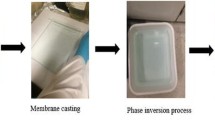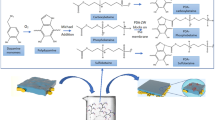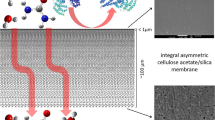Abstract
Polyaziridine or polyetyleneimine (PEI) was introduced as filler in cellulose acetate (CA) to fabricate mixed matrix membrane (MMM) for hemodialysis. Diffusion-induced phase separation (DIPS) method was followed for making PEI/CA MMM membranes. Effect of variation in the amount PEI was also examined on the morphology and performance of CA membrane. The surface morphology of pure and MMM membranes was studied by SEM, AFM, contact angle, and FTIR. Results of all characterization techniques revealed homogenous and significant blending of PEI content into pure CA matrix. Moreover, performance efficiency of MMM membranes was investigated in terms of pure water flux (PWF), urea clearance, and bovine serum albumin (BSA) rejection. The concomitant decrease of contact angle from 78° to 69° in PEI/CA MMM membranes of varying composition successfully demonstrates enhancement in surface hydrophilicity of MMM membranes. For protein rejection, all PEI/CA MMM membranes rejected > 90% of BSA relative to 25% for pure CA membrane. Furthermore, urea clearance behavior for PEI/CA MMM membranes was 67.6% in comparison to 52% for pure CA membrane. The incorporation PEI appreciably enhanced the PWF, BSA rejection, and urea clearance of CA membrane for hemodialysis application.












Similar content being viewed by others
References
Sajitha, C. J., & Mohan, D. (2005). Studies on cellulose acetate-carboxylated polysulfone blend ultrafiltration membranes. III. Journal of Applied Polymer Science, 97, 976–988.
Aliane, A., Bounatiro, N., Cherif, A. T., & Akretche, D. E. (2001). Removal of chromium from aqueous solution by complexation ultrafiltration using awater-soluble macroligand. Water Research, 35, 2320–2326.
Arthanareeswaran, G., Thanikaivelan, P., Srinivasn, K., & Mohan, D. (2004). Synthesis, characterization and thermal studies on cellulose acetate membranes with additive. European Polymer Journal, 40, 2153–2159.
Ma, H., Bowman, C. N., & Davis, R. H. (2000). Membrane fouling reduction by back-pulsing and surface modification. Journal of Membrane Science, 173, 191–200.
Teatini, U., Liebchen, A., Nilsson, L. G., Beck, W., & Romei Longhena, G. (2016). Effect of a more permeable dialysis membrane on ESA resistance in hemodialysis patients- a pilot investigation. Blood Purification, 41, 80–86.
Arindam, B., & Himadri, C. (2014). Assesment of rheological models for prediction of transport phenomena in stenosed artery. PCFD, 14, 6.
Bit, A., & Chattopadhyay, H. (2014). Numerical investigation of pulsatile flow in stenosed artery. Acta of Bioengineering and Biomechanics, 16, 33–44.
Gijsen, F. J. H., Van de Vosse, F. N., & Jansen, J. D. (1999). The influence of the non-Newtonian properties of blood on the flow in large arteries: Steady flow in a carotid bifurcation model. Journal of Biomechanics, 32, 601–608.
Feng, W., Zhu, S., Ishihara, K., & Brash, J. L. (2005). Adsorption of fibrinogen and lysozyme on silicon grafted with poly(2-methacryloyloxyethyl phosphorylcholine) via surface-initiated atom transfer radical polymerization. Langmuir, 21, 5980–5987.
Hayama, M., Yamamoto, K., Kohori, K., & Sakai, K. (2004). How polysulfone dialysis membranes containing polyvinylpyrrolidone achieve excellent biocompatibility? Journal of Membrane Science, 234, 41–49.
Dunweg, G., Lother, S., & Wolfgang, A. (1995). Dialysis membrane made of cellulose acetate. US Patent, 5, 403,485.
Ferjani, E., Lajimi, R. H., & Deratani, A. (2002). Bulk and surface modification of cellulose diacetate based RO/NF membranes by polymethylhydrosiloxane preparation and characterization. Desalination, 146, 325–330.
Qin, J. J., Oo, M. H., Cao, Y. M., & Lee, L. S. (2005). Development of a LCST membrane forming system for cellulose acetate ultrafiltration hollowfiber. Separation and Purification Technology, 42, 291–295.
Qin, J. J., Li, Y., Lee, L. S., & Lee, H. (2003). Cellulose acetate hollow fiber ultrafiltration membranes made from CA/PVP 360 K/NMP/water. Journal of Membrane Science, 218, 173–183.
Nowak, K. M., Kowalska, I., & Korbutowicz, M. K. (2005). Ultrafiltration of SDS solutions using polymeric membranes. Desalination, 184, 415–422.
Zularisam, A. W., Ismaila, A. F., Salimc, M. R., Sakinaha, M., & Ozakid, H. (2007). The effects of natural organic matter (NOM) fractions on fouling characteristics and flux recovery of ultrafiltration membranes. Desalination, 212, 191–208.
Ramírez, J. L. B., Oviedo, M. D. C., & Alonso, J. M. Q. (2006). Comparative studies of reverse osmosis membranes for wastewater reclamation. Desalination, 191, 137–147.
Boricha, A. G., & Murthy, Z. V. P. (2010). Preparation of N, O-carboxymethyl chitosan/cellulose acetate blend nanofiltration membrane and testing its performance in treating industrial wastewater. Chemical Engineering Journal, 157, 393–400.
Arockiasamy, D. L., Nagendran, A., Shobana, K. H., & Mohan, D. (2009). Preparation and characterization of cellulose acetate/aminated polysulfone blend ultrafiltration membranes and their application studies. Separation Science and Technology, 44, 398–421.
Brousse, C. L., Chapurlat, R., & Quentin, J. P. (1976). New membranes for reverse osmosis. I. Characteristics of the base polymer: sulphonated polysulphones. Desalination, 18, 137–153.
Brown, W., Henley, D., & Ohman, J. (1963). Studies on cellulose derivatives part I. The dimensions and configuration of sodium carboxymethyl cellulose in cadoxen and the influence of the degree of substitution. Die Makromolekulare Chemie. Rapid Communications, 62, 164–182.
Cerqueira, D. A., Valente, A. J. M., Filho, G. R., & Burrows, H. D. (2009). Synthesis and properties of polyaniline-cellulose acetate blends: The use of sugarcane bagasse waste and the effect of the substitution degree. Carbohydrate Polymers, 78, 402–408.
Vijayalakshmi, A., Arockiasamy, D. L., Nagendran, A., & Mohan, D. (2008). Separation of proteins and toxic heavy metal ions from aqueous solution by CA/PC blend ultrafiltration membranes. Separation and Purification Technology, 62, 32–38.
Rajesh, S., Maheswari, P., Senthilkμmar, S., Jayalakshmi, A., & Mohan, D. (2011). Preparation and characterisation of poly (amide-imide) incorporated cellulose acetate membranes for polymer enhanced ultrafiltration of metal ions. Chemical Engineering Journal, 171, 33–44.
Sivakμmar, M., Mohansundaram, A. K., Mohan, D., Balu, K., & Rangarajan, R. (1998). Modification of CA: Its characterization and application as an UF membranes. Journal of Applied Polymer Science, 67, 1939–1946.
Tatiana, K. Bronich. Nanomedicine: Nanotechnology, Biology and Medicine. Journal Elsevier. 12(8).
Hou, J. Z., Xue, H. L., Li, L. L., Dou, Y. L., Wu, Z. N., & Zhang, P. P. (2016). Fabrication and morphology study of electrospun cellulose acetate/polyethylenimine nanofiber. Polymer Bulletin, 73, 2889–2906.
Velu, S., Muruganandam, L., & Arthanareeswaran, G. (2015). Preparation and performance studies on, polyethersulfone ultrafiltration membranes modified with gelatin for treatment of tannery and distillery waste water. Brazilian Journal of Chemistry, 32, 179–189.
Kee, C. M., & Idris, A. (2010). Permeability performance of different molecular weight cellulose acetate hemodialysis membrane. Separation and Purification Technology, 75, 102–113.
Guan, R., Zou, H., Lu, D., Gong, C., & Liu, Y. (2005). Polyethersulfone sulfonated by chlorosulfonic acid and its membrane characteristics. European Polymer Journal, 41, 1554–1560.
Xu, Z. K., Nie, F. Q., Qu, C., Wan, L. S., Wu, J., & Yao, K. (2005). Tethering poly (ethylene glycol) s to improve the surface biocompatibility of poly (acrylonitrile-co-maleic acid) asymmetric membranes. Biomaterials, 26, 589–598.
Chen, Z., Deng, M., Chen, Y., He, G., Wu, M., & Wang, J. (2004). Preparation and performance of cellulose acetate/polyethyleneimine blend microfiltration membranes and their applications. Journal of Membrane Science, 235, 73–86.
Jia, Z., & Tian, C. (2009). Quantitative determination of polyethylene glycol with modified Dragendorff reagent method. Desalination, 247, 423–429.
Senthilkumar, S., Rajesh, S., Mohan, D., & Soundararajan, P. (2013). Preparation, characterization, and performance evaluation of poly(ether-imide) incorporated cellulose acetate ultrafiltration membrane for hemodialysis. Separation Science and Technology, 48, 66–75.
Joanna, R., Yurij, S., Kamil, A., Joanna, Z., Andrij, K., Khrystyna, H., Mateusz, M., Anderzej, B., Ostap, L., Halyna, O., & Andrzej, B. (2016). Temperature responsive properties of poly (4-vinylpyridine) coating: Influence of temperature on the wettability, morphology, and protein adsorption. RSC Advance, 90.
Velu, S., Muruganandam, L., & Arthanareeswaran, G. (2015). Preperation and performance studies on polyethersulfone ultrafiltration membranesmodified with gelatin for treatmentof tannery and distillery wastewater. Brazilian Journal of Chemical Engineering, 32, 179–189.
Idris, A., Yee, H. K., & Kee, C. M. (2009). Preparation of cellulose acetate dialysis membrane using D-glucose monohydrate as additive. Jurnal Teknologi, 51(F), Dis: 67–76.
Farrukh, S., Minhas, F. T., Hussain, A., Memon, S., Bhanger, M. I., & Mujahid, M. (2014). Preparation, characterization, and applicability of novel calix[4]arene-based cellulose acetate membranes in gas permeation. Journal of Applied Polymer Science, 131, 39985.
Idris, A., Lee, K. Y., Noordin, M., & Chan, M. K. (2008). Response surface methodology approach to study the influence of PEG and water in cellulose acetate dialysis membranes. Jurnal Teknologi, 49F, 39–49.
Iwasaki, Y., Yamato, H., Nii-Kono, T., Fujieda, A., Uchida, M., Hosokawa, A., Motojima, M., & Fukagawa, M. (2006). Insufficiency of PTH action on bone in uremia. Journal of Bone and Mineral Metabolism, 24, 172–175.
Sakai, K. (1994). Determination of pore size and pore distribution: 2. Dialysis membranes. Journal of Membrane Science, 96, 91–130.
Lesaffer, G., Smet, R. D., Lameire, N., Dhondt, A., Duym, P., & Vanholder, P. (2000). Intradialytic removal of protein-bound uraemic toxins: Role of solute characteristics and of dialyser membrane. Nephrology, Dialysis, Transplantation, 15, 50–57.
Vanholder, R. C., Smet, R. V. D., & Ringoir, S. (1992). Assessment of urea and other uremic markers for quantification of dialysis efficacy. Clinical Chemistry, 38, 1429–1436.
Eknoyan, G., Beck, G. J., Cheung, A. K., Daugirdas, J. T., Greene, T., Kusek, J. W., Allon, M., Bailey, J., Delmez, J. A., & Depner, T. A. (2002). Effect of Dialysis dose and membrane flux in maintenance hemodialysis. The New England Journal of Medicine, 347, 2010–2019.
Irfan, M., Idris, A., Yusof, N. M., Khairuddin, N. F. M., & Akhmal, H. (2014). Surface modification and performance enhancement of nano-hybrid f-MWCNT/PVP90/PES hemodialysis membranes. Journal of Membrane Science, 467, 73–84.
Acknowledgements
This work was supported by School of Chemical and Materials Engineering, National University of Science and Technology, Islamabad, Pakistan and Chemical Engineering Department of University of Waterloo, Ontario, Canada.
Author information
Authors and Affiliations
Corresponding author
Additional information
Publisher’s Note
Springer Nature remains neutral with regard to jurisdictional claims in published maps and institutional affiliations.
Rights and permissions
About this article
Cite this article
Waheed, H., Hussain, A. Fabrication of Cellulose Acetate/Polyaziridine Blended Flat Sheet Membranes for Dialysis Application. BioNanoSci. 9, 256–265 (2019). https://doi.org/10.1007/s12668-019-0600-5
Published:
Issue Date:
DOI: https://doi.org/10.1007/s12668-019-0600-5




